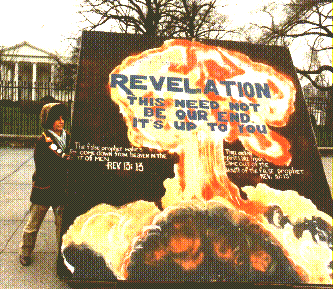Judge Lifts White House Picket Rules Washington Times
Judge Lifts White House Picket Rules
The Washington Times
THURSDAY, MAY 5, 1983
By David Sellers
Washington Times Staff A federal judge yesterday struck down new National Park Service regulations that limit the activities allowed as part of demonstrations on the sidewalk in front of the White House.
A federal judge yesterday struck down new National Park Service regulations that limit the activities allowed as part of demonstrations on the sidewalk in front of the White House.
U.S. District Judge William Bryant issued a temporary restraining order, explaining that he failed to find that an emergency existed and that federal officials should have allowed a 30-day comment period on the regulations instead of putting them into effect immediately.
"I don't think there's any justification for not having that 30-day period:' Bryant said. "There's no articulated exigency."
Although there are 20 days left in the comment period, Bryant's order is good for only 10 days. Lawyers for both sides acknowledged that they may be back before the court at a later date; but they said they would try to work out any differences among themselves.
 Assistant U.S. Attorney John Bates said he was not certain whether his office would appeal Bryant's order.
Assistant U.S. Attorney John Bates said he was not certain whether his office would appeal Bryant's order.
The new regulations, implemented April 22, prohibit individuals from exhibiting placards or signs on the White House sidewalk unless the person holds them at all times.
The regulations also provide that any packages or containers put down on a sidewalk must be attended and law-enforcement officials must be permitted to search the property. The property also may not be permitted to remain on the sidewalk for more than an hour Bates argues that there are three reasons to support implementation of the regulations: security, congestion and enjoyment of the White House. Although Bates claimed that the demonstrators impede pedestrian and vehicular traffic and "limit the significance and enjoyment of the White House experience for the public:' he based most of his argument on the security concern. "These are carefully considered regulations that have a minimal impact," Rates argued. "There's no attempt to ban people from demonstrating ."
Two government witnesses who testified at yesterday's hearing, Secret Service Assistant Director Jerry Parr and U.S. Park Police Deputy Chief James Lindsey, said that recent events convinced them of the need for the regulations. Specifically, they referred to last week's explosion at Fort McNair in Southwest Washington, the bombing of the American embassy in Beirut and the incident involving Norman Mayer, who last year threatened to blow up the Washington Monument with 1,000 pounds of dynamite he said he had in his truck, Mayer was a frequent demonstrator in front of the White House.
ACLU legal director Arthur Spitzer, who represents several demon- strators including the White House Vigil for the ERA Committee, based his argument on two areas: the merits of the regulations and the method by which they were implemented.
Spitzer contended that the government had been considering the regulations for several months and that there was no emergency that Justified bypassing the 30-day comment period.
Spitzer also argued that the regular protesters, including one of his clients, Edward Saffron, who has demonstrated in front of the White House for 14 years, were mindful of the needs of the public and allow tourists to have a clear view of the White House.
"Here the First Amendment interest is paramount. It's not a privilege to use the White House sidewalk; anyone can walk there," Spitzer said.
(picture: Connie holding sign "Quick return to the White House beat". A day after a federal judge issued a temporary restraining order against enforcement of rules governing picketing at the White House, this protester arrived to carry her sign and take up a sitting position along the wall.)


No comments:
Post a Comment